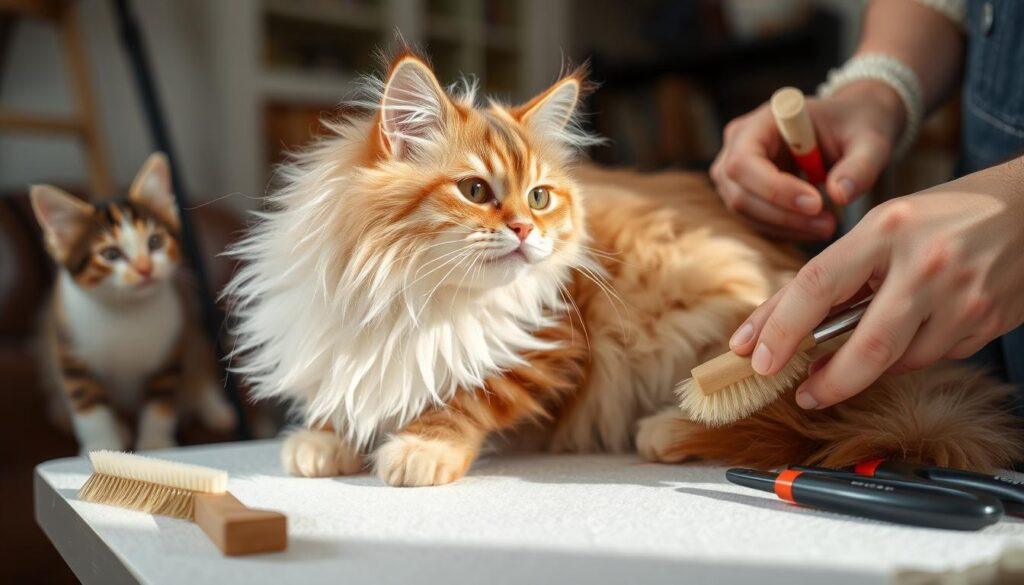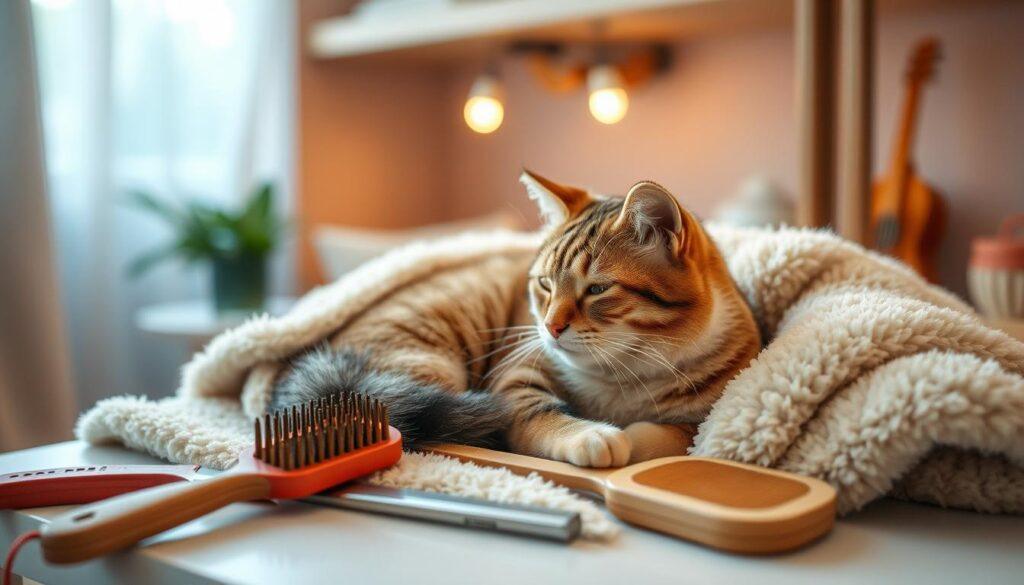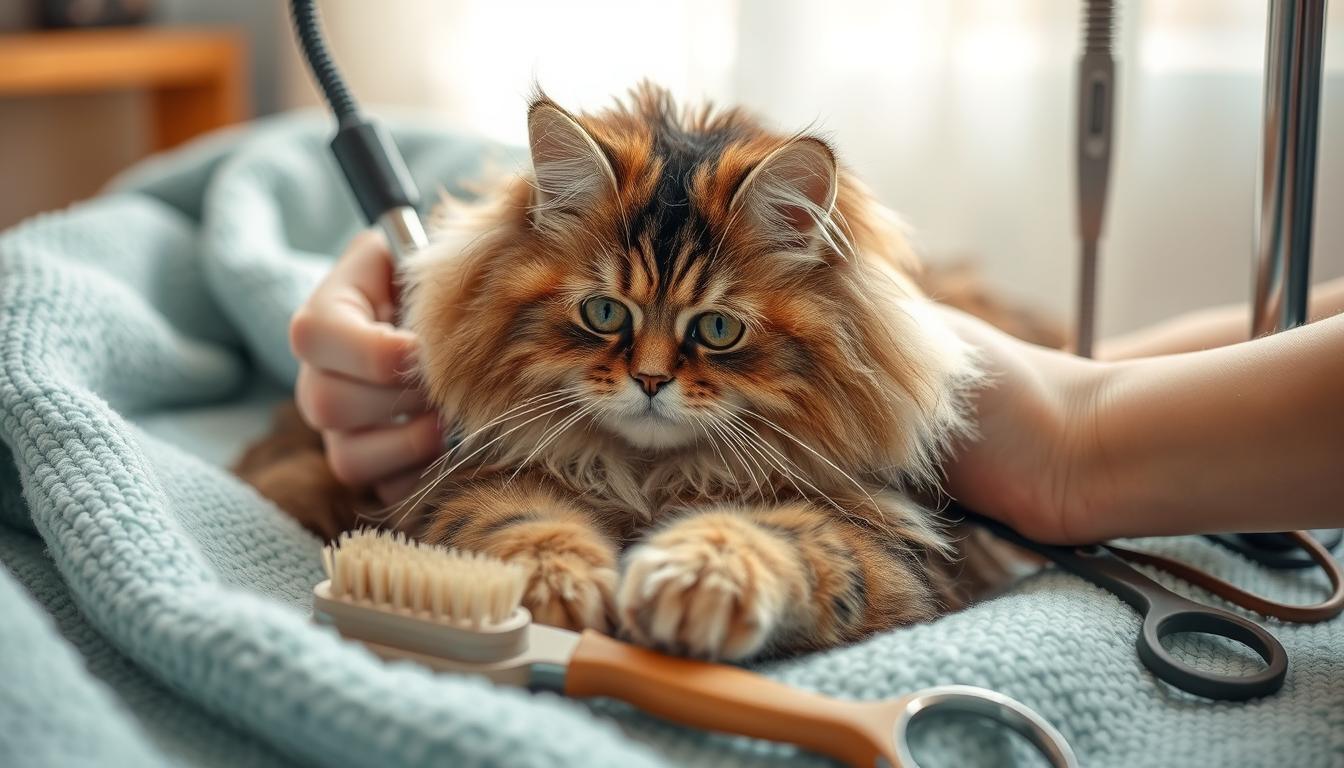Did you know that 90% of cats show stress signs during grooming1? This fact shows how vital it is to know how cats act and use safe ways to hold them during grooming. Using the right cat grooming restraints keeps both the cat and the groomer safe. It also makes grooming a better experience for everyone.
Most cats like being handled confidently during grooming1. But, every cat is different. Their mood can change based on their age, health, and past experiences. By adjusting grooming to fit each cat and using the right restraints, we can make grooming less stressful and safer.
There are many ways to keep cats safe during grooming. Using towels gently, air muzzles or e-collars when needed, and grooming loops and carriers can help. Having someone to help with holding the cat is also very helpful, especially for anxious or aggressive cats.
Key Takeaways
- Understand feline behavior and temperament to tailor the grooming process accordingly
- Create a calm environment and gather necessary tools before beginning the grooming session
- Employ safe restraint methods such as towels, air muzzles, e-collars, grooming loops, and carriers
- Adapt restraint techniques to individual cat needs and consider seeking assistance when necessary
- Consult with a veterinarian for guidance on the best restraint and grooming techniques for your cat
Understanding Feline Behavior and Temperament
To make grooming a positive experience for cats and their owners, it’s key to understand cat behavior. Knowing how cats react to grooming helps groomers make the process more comfortable. This way, both cats and their owners enjoy the grooming session.

Recognizing Different Cat Temperaments
Cats come in many different temperaments, shaped by their breed, age, and health. For instance, some breeds like Siamese and Burmese cats have a tendency to chew compulsively, known as pica2. Knowing these traits helps groomers adjust their methods. Older cats, especially those around 19 years old, need extra care and gentleness during grooming3.
Factors Influencing Cat Behavior During Grooming
Several things can affect a cat’s behavior during grooming. Their health, past experiences, and stress from their environment play big roles. It’s important for groomers to keep the environment calm and peaceful to avoid aggression2. Male cats may also show signs of urinary tract infections through inappropriate urination or spraying, needing careful attention during grooming2.
| Factor | Influence on Cat Behavior |
|---|---|
| Breed | Certain breeds may have specific grooming needs or behavioral traits |
| Age | Elderly cats may require extra patience and gentleness |
| Health Conditions | Medical issues can impact a cat’s tolerance for grooming |
| Past Experiences | Negative grooming experiences can lead to fear or aggression |
| Environmental Stressors | Unfamiliar surroundings or loud noises can cause anxiety |
Importance of Tailoring the Grooming Process to Each Cat
Every cat is different, and their behavior is influenced by many factors. Groomers need to adjust their techniques for each cat. This might mean changing the grooming environment, using certain tools, or handling them differently. For example, while muzzling is sometimes needed, most cats dislike it, so groomers should look for other ways to restrain them3.
By understanding cat behavior and adapting grooming to each cat, groomers can make the experience safer and more positive. As more groomers focus on low-stress handling, it’s clear that the cat’s well-being is key to successful grooming3.
Preparing for Safe and Stress-Free Cat Grooming
For cat grooming tips, a calm space is key. Pick a small room with closed doors and windows. This helps your cat feel safe and keeps distractions away. Brush your cat’s coat 1-2 times a week for their skin health4.
Long-haired cats like Persians or Maine Coons need more grooming. Their coats are dense and can mat easily5.
Creating a Calm Environment
To calm your cat during grooming, play soft music or use pheromone diffusers. Speak softly and give treats to make grooming positive. Regular grooming keeps your cat looking good and healthy, preventing health issues6.

Gathering Necessary Grooming Tools and Supplies
Get all grooming tools and supplies ready before starting. You’ll need:
- Brushes and combs for your cat’s coat
- Nail clippers for cats
- Ear cleaner and cotton balls
- Towels for gentle restraint and drying
- Treats for positive reinforcement
Choosing the right grooming tools is crucial. Use soft-bristle brushes, rubber mitts, wide-toothed combs, or slicker brushes for your cat’s coat6. Senior cats or overweight cats may need extra help with grooming5.
The key to successful cat grooming is patience, understanding, and tailoring the process to your cat’s individual needs and temperament.
By following these pet grooming best practices and understanding your cat’s behavior, grooming can be safe and stress-free. Cats of all ages and breeds can get skin problems, especially young, old, or stressed cats4. Regular grooming keeps your cat healthy and looking great.
Safe and Effective Cat Restraint Methods
When it comes to cat handling for groomers, using safe and effective restraint is key. It makes sure both the cat and the groomer have a stress-free time. Different methods work best based on the cat’s personality and the grooming task.
Using Towels for Gentle Restraint
Wrapping a cat in a towel is a simple yet effective way to restrain them safely. It gives them a sense of security and comfort, helping them relax during grooming7. Towels can also distract or gently hold a cat in place while grooming specific areas.
Employing Air Muzzles and E-Collars
For cats that might bite, air muzzles and e-collars are good for protection. They let the cat see and move a bit, but still keep them safe. It’s important to introduce these tools slowly and with positive rewards to make the cat comfortable with them.
Proper Use of Grooming Loops and Carriers
Grooming loops are useful for keeping a cat in place, but they should never be around the neck alone. A safer option is a figure-eight loop around the neck and behind the front legs. Carriers can also help keep a cat secure or supported during grooming.
The Role of Assistants in Cat Grooming
A well-trained assistant is very helpful in cat grooming. They can help with holding, distracting, and checking if the cat is comfortable. It’s important for the groomer and assistant to communicate well to avoid accidents and make sure the cat has a good experience8.
| Restraint Method | Best Used For | Key Points |
|---|---|---|
| Towels | Calming, gentle restraint | Wrap snugly, use as distraction |
| Air Muzzles/E-Collars | Bite prevention | Introduce gradually, allow visibility |
| Grooming Loops | Securing cat in place | Use figure-eight loop, not just neck |
| Carriers | Containment, support | Utilize for specific tasks |
| Assistants | Restraint, monitoring | Clear communication is key |
The goal of safe cat restraint methods is to make grooming a positive and stress-free experience. This strengthens the bond between the cat and its owner7. By choosing the right techniques for each cat and focusing on their comfort, groomers can make sure everyone has a good experience.
How to Restrain a Cat for Grooming
Grooming a cat can be tough, especially since many think it’s not needed9. But, cats really do need help for a good grooming9. To make grooming safe and stress-free, knowing how to handle cats and adjust restraint methods is crucial.
Techniques for Holding and Supporting Cats During Grooming
When grooming a cat, it’s important to hold them right and keep them comfortable10. Using different parts of your body can make cats feel safer and more supported. Getting cats used to grooming tools can also help them get used to grooming9.
Tools like grooming mitts or rubber brushes are gentler and might be better for some cats10. A grooming spray can also help remove loose hairs10.
Safely Scruffing a Cat When Necessary
Most cats don’t like being held or carried9. Scruffing should only be used when it’s really needed to avoid bites or to quickly calm a cat. When scruffing, make sure to support their body to avoid hurting them.
“Scruffing should only be used as a last resort and with great care to ensure the cat’s safety and comfort.”
Adapting Restraint Methods to Individual Cat Needs
About 95% of cats don’t mind grooming, but some can be very aggressive10. Some breeds, like Chinchilla Persians, might even howl when touched gently10.
To handle these challenges, groomers can use different restraint methods, such as:
- Wrapping cats in a towel for grooming9
- Using cat muzzles to keep them calm9
- Having another person help with grooming9
| Cat Temperament | Suitable Restraint Method |
|---|---|
| Calm and cooperative | Gentle handling and support |
| Fidgety or anxious | Towel wrap or grooming loop |
| Aggressive or biting | Air muzzle or e-collar (with caution) |
Adapting restraint methods to each cat’s individual needs is key to ensuring a safe and successful grooming experience.
Handling Aggressive or Anxious Cats During Grooming
When grooming cats, patience and understanding are key. Cats spend a lot of time grooming themselves11. But, some may only tolerate a few minutes of grooming11. It’s important to be friendly and firm, never using force or fear.
Each cat is different, so grooming needs to be tailored to them. Anita Kelsey, a mobile cat groomer, specializes in grooming all types of cats. She uses low-stress techniques12. Finding a quiet space for grooming is crucial for nervous cats11.
Dealing with aggressive or anxious cats requires rewards and confidence. Start grooming cats early to help them get used to it11. If a cat gets too stressed or aggressive, stop grooming. In some cases, sedation might be needed12.
Pet grooming best practices mean knowing when a cat is too anxious. Look for signs of severe anxiety and seek vet help11. Matted fur may need professional trimming to avoid pain for the cat11. Anita Kelsey, who focuses on one client a day, is great for tough cases12.
“No archaic face muzzles or restraints are used during grooming sessions, instead, compassionate low-stress handling techniques are applied.” – Anita Kelsey, cat behaviour counselor and expert in low-stress cat grooming12
Alternative Grooming Options for Difficult Cats
Some cats are hard to groom, especially those with long hair. They can get mats and tangles if not brushed often13. Shy cats or those who have endured negative grooming experiences might steer clear of it altogether13. For cats with arthritis, grooming can be a painful challenge, making the process difficult13.
Cats need help to keep their coat and health in check14. A good grooming kit is key, with tools like brushes and shampoos14.
Considering Sedation or Medication for High-Stress Cats
For cats that get really stressed during grooming, there are other ways. Professionals like groomers or vets can help with severe mats13. In some cases, a vet might suggest sedation to make grooming safe and comfortable.
Discussing Grooming Challenges with Veterinarians
Talking to your vet about grooming challenges is important. They can offer advice and suggest grooming methods that work for your cat.
| Grooming Challenge | Potential Solution |
|---|---|
| Matted or tangled fur | Apply olive oil to the mat and gently work it out15 |
| Cat dislikes brushing | Use grooming gloves or provide treats during brushing14 |
| Aggressive behavior during grooming | Consult with a veterinarian for sedation or medication options |
Using olive oil to fix mats needs room temperature oil. Be ready for oil spills on surfaces where your cat sleeps15. Positive rewards can help pets feel better about grooming15.
Understanding your cat’s needs and working with vets can help. This way, you can overcome cat grooming challenges and keep your cat healthy and groomed.
Conclusion
Grooming your cat at home needs patience, understanding, and the right techniques. This ensures a safe and stress-free experience for both you and your cat. By knowing your cat’s temperament and tailoring grooming to them, you can make grooming sessions calm and positive16.
Having the right tools and supplies is key for a successful grooming session17. This includes gentle cat shampoo, clean water for rinsing, and towels. These items help make grooming easier and more effective.
When grooming your cat, using safe and effective restraint methods is important. Tools like towels, air muzzles, e-collars, grooming loops, and carriers can keep your cat secure and comfortable. Adapting these methods to your cat’s needs and getting help when needed can make grooming easier16.
For aggressive or anxious cats, grooming needs extra care and consideration. Introduce grooming tools slowly, use positive reinforcement, and give breaks when needed. This can help reduce stress and aggression18.
In some cases, grooming may need to be done under sedation or with medication. Talking to your vet can help find the best way to groom your cat16. By following these pet grooming best practices, you can make grooming a bonding experience. This promotes a healthy coat, skin, and overall well-being for your cat.
FAQ
What is the purpose of restraining a cat during grooming?
How can understanding a cat’s temperament and behavior help with grooming?
What should I do to prepare for a successful cat grooming session?
What are some safe and effective cat restraint methods?
How can a groomer use their body to help restrain a cat during grooming?
What should I do if a cat becomes aggressive or anxious during grooming?
What are some alternative grooming options for difficult cats?
Source Links
- How to Safely Restrain a Cat: Dr. Karyn Shares Her Tips (with Video) – Catster – https://www.catster.com/felines-weekly/how-to-safely-restrain-a-cat-dr-karyns-tips/
- A Beginners Guide to Cat Behavior – https://www.tuftandpaw.com/blogs/cat-guides/beginners-cat-behavior-guide?srsltid=AfmBOoqRtGb5Odn4Ud6dzsv3R1k-IR7xOhZPWoHupnVOe9UjDU8anSTj
- Understanding cat behaviour during grooming – https://www.catbehaviourist.com/blog/understanding-cat-behaviour-grooming/
- Cat Grooming Tips – https://www.aspca.org/pet-care/cat-care/cat-grooming-tips
- The Essential Guide to Cat Grooming and Bathing: Tips, Frequency and Hygiene – ZumVet Blog – https://zumvet.com/blog/the-essential-guide-to-cat-grooming-and-bathing-tips-frequency-and-hygiene/
- Cat Grooming Tips – https://www.groomersu.com/blog/cat-grooming-tips
- How to Gently Restrain Your Cat for Grooming | My Pet Needs That – https://www.mypetneedsthat.com/restrain-a-cat-for-grooming
- Course Content and Outcomes Guides (CCOG) at PCC – https://www.pcc.edu/ccog/vt/102/
- How to Gently Restrain Your Cat For Grooming | Pet Side – https://www.petside.com/restrain-cat-for-grooming/
- Grooming Aggressive Cats – https://www.groomarts.com/blogs/2017/grooming-aggressive-cats
- 5 Cat Grooming Tips for Nervous Cats – https://curiouscatpeople.com/blogs/cat-talk/5-cat-grooming-tips-for-nervous-cats
- Grooming aggressive or nervous cats – https://www.catbehaviourist.com/blog/stress-free-cat-grooming/
- How to Groom a Cat That Hates It: 8 Vet-Approved Tips – Catster – https://www.catster.com/lifestyle/how-to-groom-a-cat-that-hates-it/
- 10 Essential Cat Grooming Supplies To Get You Started – https://kingstownecatclinic.com/2024/11/10-essential-cat-grooming-supplies-to-get-you-started/
- Oiling Point Of Fur Mats (Using Olive Oil To Remove Clumps Of Matted Fur) – https://www.karikells.com/Petsitter/2017/olive-oil-to-remove-matted-fur/
- (10) Easy Steps for Grooming Your Dog or Cat. | SUPERIOR ANIMAL CLINIC – https://superioranimalclinicvet.com/10-simplified-steps-of-grooming-a-pet-dog-or-cat/
- How to restrain a cat for bath – Pets Hall – https://petshall.com/how-to-restrain-a-cat-for-bath/
- What if my cat has aggressive behavior? – Charlie’s Grooming Studio – Dog Grooming Services Calgary – https://calgarydoggrooming.ca/what-if-my-cat-has-aggressive-behavior/

